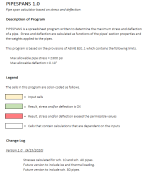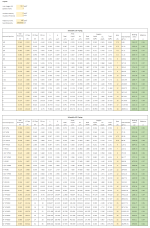PIPESPANS V1

Description
PIPESPANS is a spreadsheet program written to determine the maximum stress and deflection of a pipe. Stress and deflection are calculated as functions of the pipes' section properties and the weights applied to the pipes.
To calculate the minimum required wall thickness according to ASME B31.1-2007, you can use the same formula:
t = (P * D) / (2 * S * E + P * Y)
where:
- t is the minimum required wall thickness (mm or in)
- P is the internal design pressure (MPa or psi)
- D is the outside diameter of the pipe (mm or in)
- S is the allowable stress for the pipe material at the design temperature (MPa or psi), as per ASME B31.1-2007
- E is the longitudinal weld joint quality factor (dimensionless)
- Y is the coefficient that accounts for material strength variation in the hoop and axial directions (dimensionless)
For ASME B31.1-2007, you can find the allowable stress (S) in Table A-1 (for ferrous materials) or Table A-2 (for nonferrous materials).
Regarding the maximum span allowed between supports for a pipe, ASME B31.1 does not provide a specific formula. However, it does provide guidelines for determining the spacing based on the pipe size, material, and operating conditions. One common method for determining the spacing between pipe supports is to use the 'simple beam theory,' which involves calculating the bending stress and deflection in the pipe under its weight and any additional loads (such as insulation or fluid weight). This method can be used in conjunction with the allowable stress (S) from ASME B31.1-2007 and the calculated pipe wall thickness (t).
There are also some general guidelines and industry practices for determining pipe support spacing based on pipe size and material. For example, the Pipe Support Spacing Chart in ASME B31.1-2007, Table 121.5, provides suggested support spacing for carbon steel pipes based on nominal pipe size and operating temperature. These values can be used as a starting point, but the actual spacing should be determined based on the specific requirements of your piping system, including factors such as thermal expansion, vibration, and wind loads.
Keep in mind that the pipe support spacing and the minimum required wall thickness should be evaluated together to ensure that the overall piping system is designed to withstand the various loads and stresses it will encounter during operation.
Calculation Preview
Full download access to any calculation is available to users with a paid or awarded subscription (XLC Pro).
Subscriptions are free to contributors to the site, alternatively they can be purchased.
Click here for information on subscriptions.



